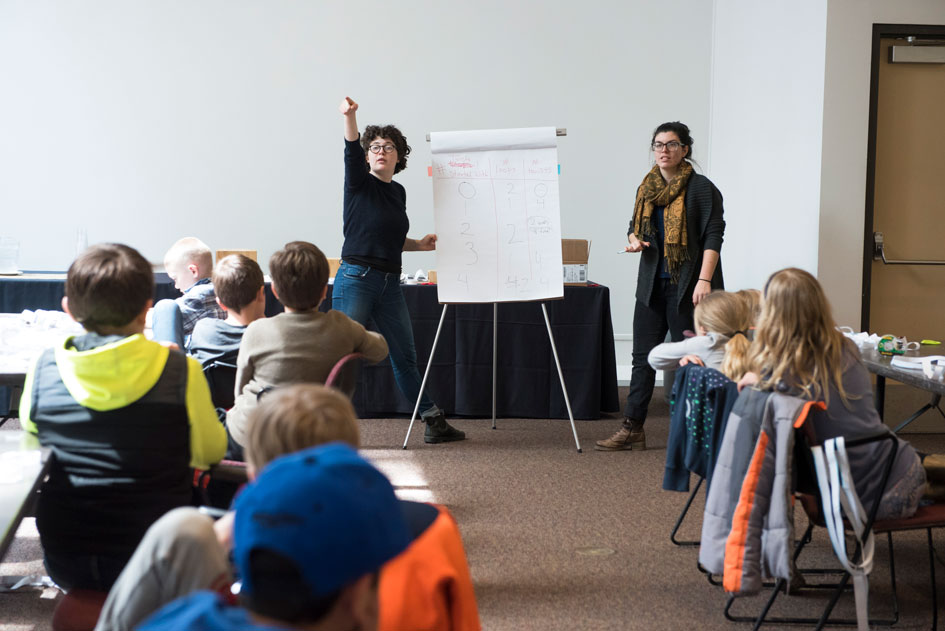Playing With Patterns
Reed students bring the thrill of mathematical and algorithmic thinking to local public schoolchildren.
When math/physics majors Sarah Racz ’18 and Aja Procita ’18 first showed up at Lewis Elementary to give the local grade-schoolers a taste of mathematics—Reed-style—the third-grade teacher introduced them to his class as “mathematicians.” During question time, one of the third-graders wondered why the Reed students “don’t look like mathematicians.”
Quick on the uptake, Aja asked the third-grader what mathematicians look like. “They probably wear glasses,” came the rejoinder. It was a telling moment. Aja and Sarah were both wearing glasses.
“That’s exactly why we started this program,” says Prof. Dana Katz [art history], a driving force behind Reed’s Math and Computer Science Outreach program, now finishing its second year. She wanted to create a project in the vein of the Reed’s hugely successful Science Outreach program to help kids in local public schools reimagine what math is and who can pursue it. Having math and computer science taught by young people—especially young women—can inspire grade-schoolers to consider fields which were not, historically, accessible to everyone.
Prof. Katz teamed up with Prof. Irena Swanson ’87 [mathematics] and special programs director Barbara Amen to establish the program. “Our goal is to show the students that math is about thinking and that it is fun,” says Prof. Swanson, who developed the curriculum. “We are trying to catch the students at that curious age before they might fall into the trap of thinking any of those negative stereotypical thoughts about mathematics or studying in general.”
The program was launched in 2016 with two Reed students teaching in a math classroom and two in a computer science classroom once a month. Teachers and students at Lewis Elementary liked it so much that the program was expanded this year to include eight student-teachers covering four different classrooms. Both the math and computer science sessions are keyed towards illuminating foundational concepts that spark students’ interest. For example, the math curriculum features topics such as Pascal’s Triangle, Möbius strips, tessellations, and logic. The computer science curriculum includes instruction on binary numbers, sorting, coding in Python, and cryptography. Laura Israel ’17 (a psychology major) and Meaza Abate ’18 (one of Reed’s first CS majors) were instrumental in developing interactive lessons that will be used by future CS outreach instructors.
“We are not trying to get the kids to be better at calculating,” says Prof. Swanson. “But we want them to get good at reasoning and to have fun with it for lasting effect.”
A recent math session at Lewis began with the grade-schoolers sitting patiently on the floor at the front of the classroom. The Reed mathematicians led a unit on the Fibonacci sequence (a series of numbers in which each number is the sum of the two preceding, such as 1, 1, 2, 3, 5, 8...) and how it dovetails with Pascal’s Triangle, a concept the students had already studied. The students learned how Fibonacci sequences are surprisingly common in nature, occurring in the arrangement of leaves on stems, branching on trees, the order of a pine cone’s bracts, or even the unfurling of a fern. The Fibonacci sequence can also be visualized in a spiral based logarithmically on the golden ratio. The unit included many examples of these spirals in biological settings, such as the seeds of a sunflower, the shell of a nautilus, and the curvature of the human ear (these geometrical iterations are not technically measurable as Fibonacci sequences, but they function well as a means of illustrating the phenomenon).
Afterwards the whole class went out to hunt for examples of sequences in the school’s garden and playground. They collected pine cones, examined the branching patterns of trees and the rings of stumps, and studied the different arrangement of leaves. One of the third-grade girls approached me, clutching a pine cone.
“Does this pine cone count as Fibonacci?” she wanted to know.
“You know... I’m not sure,” I replied. Her face fell for a moment.
“We’ll have to ask the mathematicians!” She brightened again, immediately, and ran to join the group of excited students surrounding the two instructors.
Congratulations to the Reed students who participated in the Math/CS Outreach program: Laura Israel ’17, Meaza Abate ’18, Ira Globus-Harris ’18, Andie Hoshijo ’18, Rhody Kaner ’18, Miranda McGough ’18, Aja Procita ’18, Sarah Racz ’18, Torin Woods-Eliot ’18, and Hannah Mead ’19.
Tags: Campus Life, Cool Projects, Service, Students
